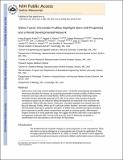| dc.contributor.author | Aiden, Aviva Presser | |
| dc.contributor.author | Rivera, Miguel N. | |
| dc.contributor.author | Rheinbay, Esther | |
| dc.contributor.author | Ku, Manching | |
| dc.contributor.author | Coffman, Erik J. | |
| dc.contributor.author | Truong, Thanh T. | |
| dc.contributor.author | Vargas, Sara O. | |
| dc.contributor.author | Haber, Daniel A. | |
| dc.contributor.author | Bernstein, Bradley E. | |
| dc.contributor.author | Lander, Eric Steven | |
| dc.date.accessioned | 2012-10-15T20:13:39Z | |
| dc.date.available | 2012-10-15T20:13:39Z | |
| dc.date.issued | 2010-06 | |
| dc.date.submitted | 2009-11 | |
| dc.identifier.issn | 1934-5909 | |
| dc.identifier.uri | http://hdl.handle.net/1721.1/73994 | |
| dc.description.abstract | Wilms tumor is the most common pediatric kidney cancer. To identify transcriptional and epigenetic mechanisms that drive this disease, we compared genome-wide chromatin profiles of Wilms tumors, embryonic stem cells (ESCs), and normal kidney. Wilms tumors prominently exhibit large active chromatin domains previously observed in ESCs. In the cancer, these domains frequently correspond to genes that are critical for kidney development and expressed in the renal stem cell compartment. Wilms cells also express “embryonic” chromatin regulators and maintain stem cell-like p16 silencing. Finally, Wilms and ESCs both exhibit “bivalent” chromatin modifications at silent promoters that may be poised for activation. In Wilms tumor, bivalent promoters correlate to genes expressed in specific kidney compartments and point to a kidney-specific differentiation program arrested at an early-progenitor stage. We suggest that Wilms cells share a transcriptional and epigenetic landscape with a normal renal stem cell, which is inherently susceptible to transformation and may represent a cell of origin for this disease. | en_US |
| dc.language.iso | en_US | |
| dc.publisher | Elsevier | en_US |
| dc.relation.isversionof | http://dx.doi.org/10.1016/j.stem.2010.03.016 | en_US |
| dc.rights | Creative Commons Attribution-Noncommercial-Share Alike 3.0 | en_US |
| dc.rights.uri | http://creativecommons.org/licenses/by/3.0/ | en_US |
| dc.source | PMC | en_US |
| dc.title | Wilms Tumor Chromatin Profiles Highlight Stem Cell Properties and a Renal Developmental Network | en_US |
| dc.type | Article | en_US |
| dc.identifier.citation | Aiden, Aviva Presser et al. “Wilms Tumor Chromatin Profiles Highlight Stem Cell Properties and a Renal Developmental Network.” Cell Stem Cell 6.6 (2010): 591–602. | en_US |
| dc.contributor.department | Massachusetts Institute of Technology. Department of Biology | en_US |
| dc.contributor.mitauthor | Lander, Eric S. | |
| dc.relation.journal | Cell Stem Cell | en_US |
| dc.eprint.version | Author's final manuscript | en_US |
| dc.type.uri | http://purl.org/eprint/type/JournalArticle | en_US |
| eprint.status | http://purl.org/eprint/status/PeerReviewed | en_US |
| dspace.orderedauthors | Aiden, Aviva Presser; Rivera, Miguel N.; Rheinbay, Esther; Ku, Manching; Coffman, Erik J.; Truong, Thanh T.; Vargas, Sara O.; Lander, Eric S.; Haber, Daniel A.; Bernstein, Bradley E. | en |
| mit.license | OPEN_ACCESS_POLICY | en_US |
| mit.metadata.status | Complete | |
